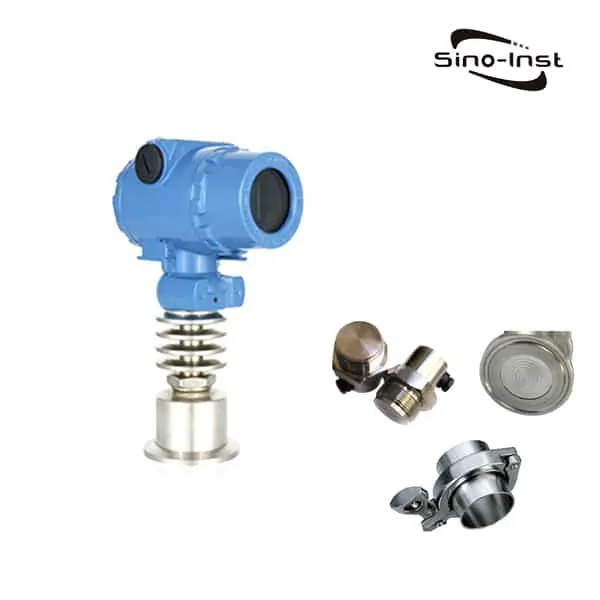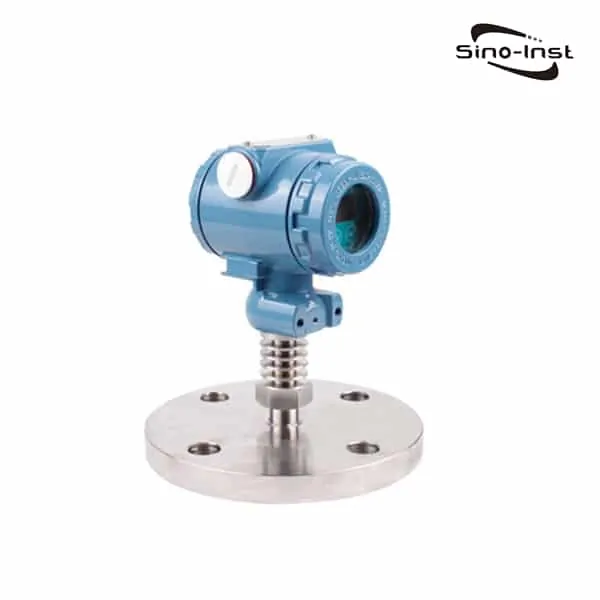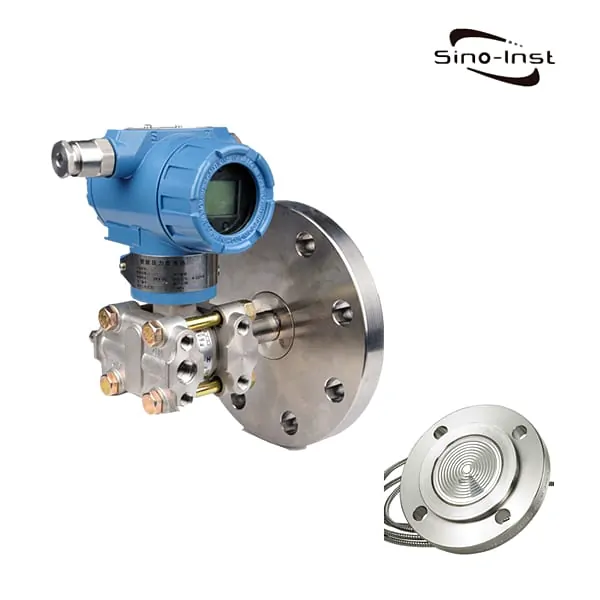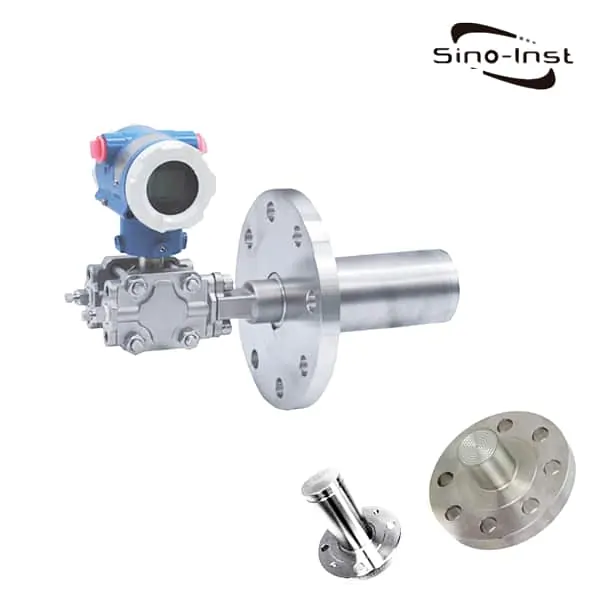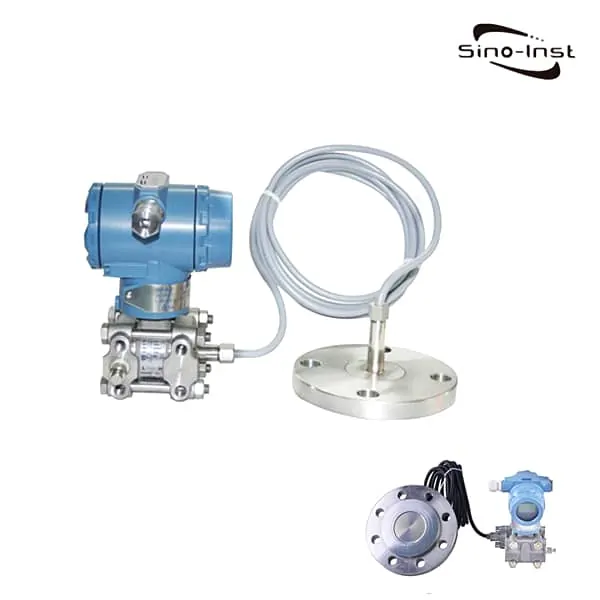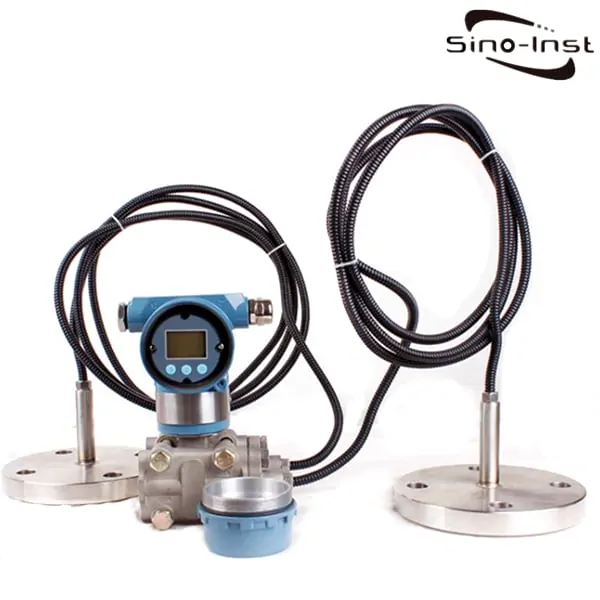Diaphragm Seal Pressure Transmitters work with Diaphragm Seals for those harsh working conditions. The purpose of the diaphragm seal is to isolate the pressure sensor from the process medium.
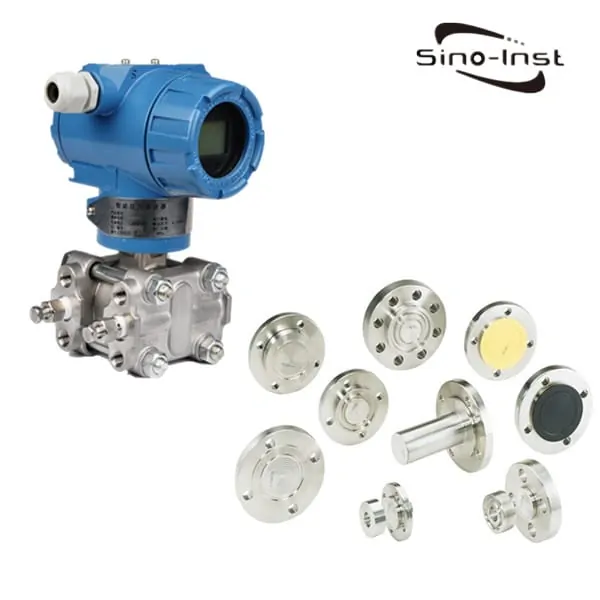
The diaphragm seal makes measuring pressure safer and more reliable. It is ideal for protecting pressure process transmitters even under harsh working conditions. The diaphragm seal can isolate the pressure sensor from the process medium. No matter absolute pressure or differential pressure measurement. Mounting with capillary and flange, Diaphragm Seal pressure transmitter can measure pressure, liquid level and flow.When the environment is extremely hot or cold, or when the process connection is difficult to connect to the measuring instrument. When the measured medium is corrosive, sticky, sticky or easily cured. Or when the process is not chemically compatible with the instrument material. It is recommended to use a diaphragm seal.
Sino-Inst offers a variety of Diaphragm Seal Pressure Transmitters for industrial pressure measurement. If you have any questions, please contact our sales engineers.
Featured Diaphragm Seal Pressure Transmitters
What is a diaphragm seal?
Diaphragm seals, also known as chemical seals or remote seals, are used for pressure measurements when the process medium should not come into contact with the pressurised parts of the measuring instrument.
A diaphragm seal has two primary tasks:
- Separation of the measuring instrument from the process medium
- Transfer of the pressure to the measuring instrument
You may like: Diaphragm pressure gauge
Advantages of diaphragm seals
Diaphragm seals offer the advantage that the “contact surface” between pressure medium and diaphragm is relatively large. Thus ensuring accurate pressure measurement, especially for very low pressures (< 600 mbar). Furthermore, they can be easily dismounted, e.g. for cleaning or calibration purposes.
Rosemount 1199
Rosemount 1199 remote transmission diaphragm system provides the world’s most extensive product variety and specifications to meet the requirements of various measurements and applications.
There are the following types of remote transmission differential pressure / level transmitters:
1) PFW flat type remote transmission device
2) RTW thread installation type remote transmission device
3) EFW inserted barrel remote transmission device
4) RFW flange mounted remote transmission device
5) SCW hygienic remote transmission device
The 1199 remote diaphragm can be assembled to Sino-Inst differential, gauge, and absolute pressure transmitters and liquid level transmitters.
We can learn more about Rosemount 1199 remote diaphragm.
How do diaphragm seals work?
Basically, diaphragm seals are used in all pressure measurement processes to avoid direct contact between the measuring instrument and the medium during this process.
In addition, if the measuring point cannot be installed or read because the measuring point is located in a hard-to-reach location, a diaphragm seal can also be used.
In both cases, the applied pressure is transferred to the measuring instrument through the system fill fluid in the diaphragm seal housing.
The diaphragm of the seal can be made of different materials, such as stainless steel, Hastelloy, Monel or tantalum. In addition, coatings with ECTFE, PFA or gold can also be used.
We can provide the best diaphragm seal design, materials, system fill fluid and accessories for each application. The combined configuration of the pressure measuring instrument and the diaphragm seal is mainly determined by the special application conditions of the diaphragm sealing system.
You may like: How does a pressure transmitter work?
Differential Pressure Transmitter Installation Guide
Diaphragm type pressure transmitter working principle
Diaphragm pressure transmitter is an automated instrument that measures fluid pressure in the industrial field.
- It is mainly composed of pressure measuring probe, capillary tube, filling liquid and pressure transmission head.
- One end of the pressure measuring probe is provided with an elastic metal diaphragm
- When the pressure acts directly on the surface of the measuring diaphragm, the diaphragm will have a slight deformation.
- The high-precision circuit on the measuring diaphragm transforms this tiny deformation into a highly linear voltage signal proportional to the pressure and also proportional to the excitation voltage.
- Then use a special chip to convert this voltage signal into an industry standard 4-2OmA current signal or 1-5V voltage signal.
- Because the measuring diaphragm adopts standard integrated circuit, which contains linear and temperature compensation circuits, it can achieve high precision and high stability.
- The transmission circuit adopts a special two-wire system chip, which can ensure the output of a two-wire 4-20mA current signal, which is convenient for field wiring.
Read more about: What is industrial pressure transmitter?
When to use diaphragm seal ?
The diaphragm seal pressure transmitter is suitable for the following working conditions:
- The high temperature medium needs to be isolated from the transmitter.
- The measuring medium has a corrosive effect on the sensitive components of the transmitter.
- Suspended liquid or high viscosity medium.
- The measured medium solidifies or crystallizes due to changes in the environment or process temperature.
- Replacing the measured medium requires strict purification of the measuring head.
- The measuring head must be kept clean and hygienic.
- Liquid level measurement of sealed pressure vessel.
Difference between bourdon tube and diaphragm pressure gauge:
Frequently
Asked
Questions
Related Blogs
Sino-Inst is a manufacturer of Diaphragm Seal Pressure Transmitters.
Sino-Inst offers over 20 Diaphragm Seal Pressure Transmitters at best price. About 50% of these are Pressure level Transducer, 40% are Differential Pressure transmitters, and 40% are Diaphragm Seal Pressure transmitters.
A wide variety of Diaphragm Seal Pressure Transmitters options are available to you, such as free samples, paid samples.
Sino-Inst is a globally recognized supplier and manufacturer of Diaphragm Seal Pressure Transmitters, located in China. Sino-Inst sells through a mature distribution network that reaches all 50 states and 30 countries worldwide. Diaphragm Seal Pressure Transmitters products are most popular in Domestic Market, Southeast Asia, and Mid East.
You can ensure product safety by selecting from certified suppliers, with ISO9001, ISO14001 certification.
Request a Quote

Wu Peng, born in 1980, is a highly respected and accomplished male engineer with extensive experience in the field of automation. With over 20 years of industry experience, Wu has made significant contributions to both academia and engineering projects.
Throughout his career, Wu Peng has participated in numerous national and international engineering projects. Some of his most notable projects include the development of an intelligent control system for oil refineries, the design of a cutting-edge distributed control system for petrochemical plants, and the optimization of control algorithms for natural gas pipelines.


